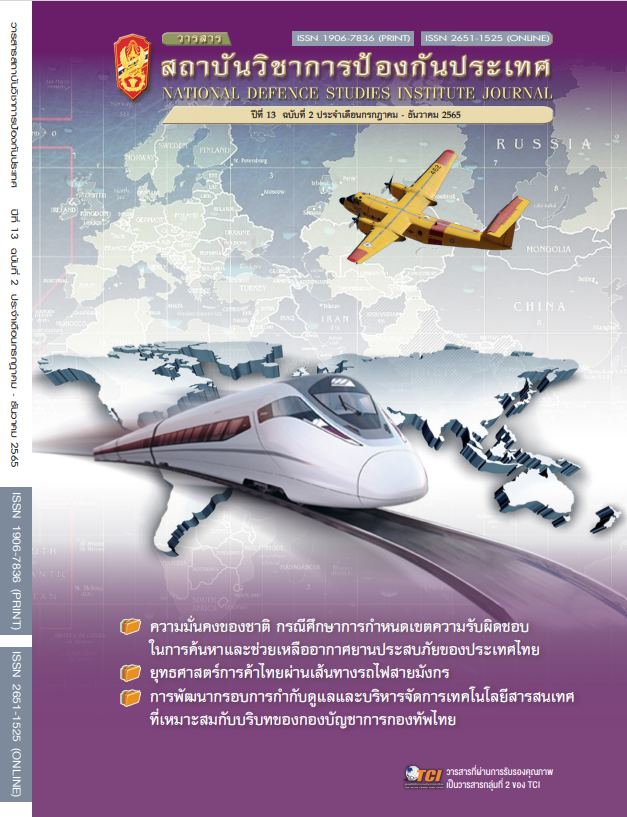The Role of Taiwan in South China Sea
Main Article Content
Abstract
This article aims to study the role of Taiwan in the South China Sea. The territorial disputes in the South China Sea is the one of the major problems that affects regional peace and stability. The overlapping ownership claims by many countries make the conflict complex to resolve. The first official claimant is Republic of China (Taiwan), who created the dash line map in 1947 to portray the territory of China in the South China Sea. After the civil war in China, the Chinese communist government has used the map to claim their rights in the South China Sea until nowadays. Therefore, the study of Taiwan’s role in the South China Sea naturally focuses on the initiation of claims, the dash line map creation, and Taiwan's occupancy of Taiping Island, the largest island in the Spratly Islands. Moreover, the role of Taiwan as a claimant is complex because it has not been internationally recognized as a sovereignty state. Consequently, Taiwan has not been invited to participate in multilateral forums, which undermines attempts to resolve the South China Sea dispute. This article collected data from relevant news, documents, and articles on the role of Taiwan in the South China Sea.
Article Details

This work is licensed under a Creative Commons Attribution-NonCommercial-NoDerivatives 4.0 International License.
The articles, images, tables, graphs, written content, and opinions published in this journal are solely those of the authors and do not necessarily reflect the views or positions of the National Defence Studies Institute or its academic affiliates.
References
ธาราทิพย์ พ่วงเชียง. (2559). เอกสารศึกษาเฉพาะกรณี เรื่อง บริบท และทิศทางการเสริมสร้างความมั่นคงร่วมทะเลจีนใต้. กรุงเทพฯ: ศูนย์ศึกษายุทธศาสตร์ สถาบันวิชาการป้องกันประเทศ.
วิศรา ไกรวัฒนพงศ์, และวรศักดิ์ มหัทธโนบล. (2559). ความขัดแย้งในทะเลจีนใต้.กรุงเทพฯ : โครงการ ความมั่นคงศึกษา.
ศิโรตม์ ภาคสุวรรณ. (2560). อาเซียนและความขัดแย้งในทะเลจีนใต้. วารสารเอเชียพิจารณ์ ศูนย์ศึกษาเอเชีย คณะรัฐศาสตร์ มหาวิทยาลัยรามคำแหง, 4(8), 59-87.
Dennis, V.H. (2018). Continuity and change: Ma Ying-Jeou, Tsai Ing-wen and the dispute in the South China Sea. The journal of territorial and maritime studies, 5(1), 64-82.
Gao, Z. & Jia, B. (2013). The Nine-Dash line in the South China Sea: history, status, and implications. The American Journal of International law. 107(1), 98-124.
Hsiao, H.A. (2016). Taiwan and the arbitral tribunal’s ruling: responses and future challenges.Contemporary Southeast Asia, 38(3), 362-368.
Jabin, T.J. (2016). Interpreting Ma Ying-jeou’s visit to Taiping island. Retrieved March, 20 2022, from https://icsin.org/blogs/2016/02/09/interpreting-ma-ying-jeous-visit-to-taiping-island/
Jacques, D. (2016). Why Taiwan president Ma Ying-jeou’s day-trip to Taiping Island was such a big deal. Retrieved May, 2 2022, from https://www.fpri.org/article/2016/02/why-taiwan-presidentma-ying-jeous-day-trip-taiping-island-was-such-big-deal/
Ko, S.L. (2008, 4 February). Chen Shui-bian defends his visit to Taiping Island. Taipei Times. Retrieved March, 15 2022, from https://www.taipeitimes.com/News/taiwan/archives/2008/02/04/2003400181
Lin, C.Y. (1997). Taiwan’s South China Sea policy. Asian Survey, 37(4), 323-339.
Lin, T.H. (2018). Taiwan’s policy evolution after the South China Sea Arbitration. Retrieved
March, 18 2022, from https://www.nbr.org/publication/taiwans-policy-evolution-after-the-southchina-sea-arbitration/
Ministry of Foreign Affairs, ROC (Taiwan). (2015). Taiping Island in the South China Sea. Retrieved from https://www.youtube.com/watch?v=4_fDk_Y8zQI
Office of the President Republic of China (Taiwan), (2016). President Tsai attends exhibition commemorating 70th anniversary of recovery of South China Sea Islands. Retrieved May, 20 2022, from https://english.president.gov.tw/News/5036
Song, Y.H. (2015). Legal status of Taiping island under the United Nations convention on the law of the sea. Korean Journal of International and comparative law, 2015(3), 115-138.
Taipei Economic and Cultural office in Chicago. (2016). South China Sea Peace Initiative. Retrieved March, 31 2022, from https://www.roc-taiwan.org/uschi_en/post/974.html
Tseng, H.Y.K. (2015). Taiwan in the South China Sea Disputes: Policies and Prospects. In: Huang, J., Billo, A. (eds), Territorial Disputes in the South China Sea. (p.128-144)., London: Palgrave Macmillan.
U.S.-China Economic and Security Review Commission. (2016). South China Sea Arbitration ruling: what happened and what’s next?. Retrieved June, 1 2022, from https://www.uscc.gov/research/south-china-sea-arbitration-ruling-what-happened-and-whats-next
Wei, P. (2015, 16 July). How the Eleven-Dash Line became a Nine-Dash Line and other stories.Radio Free Asia. Retrieved April, 1 2022, from https://www.rfa.org/english/commentaries/line-07162015121333.html
Wu, J.R. (2016, 28 January). Taiwan president says visit to disputed island was to promote peace. Reuters. Retrieved April, 12 2022, from https://www.reuters.com/article/us-taiwan-southchinaseaidUSKCN0V600J
Zheng, W. (2015). Chinese Discourse on the Nine-Dashed Line. Asian Survey, 55(3), 502-524


